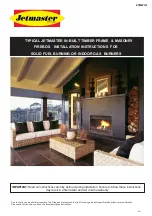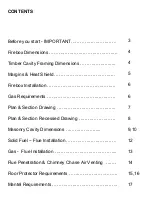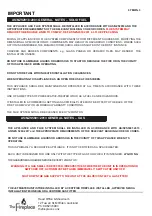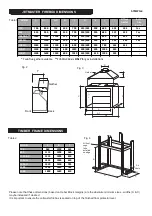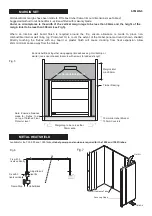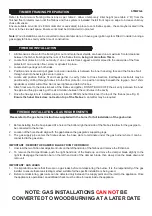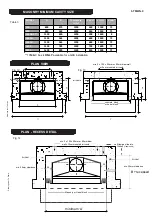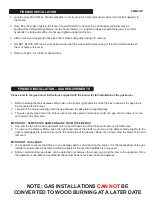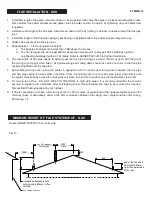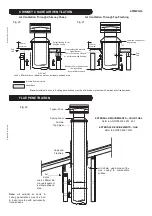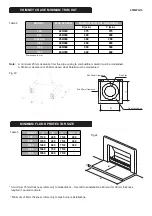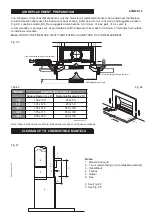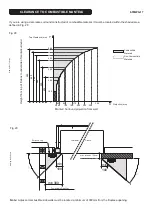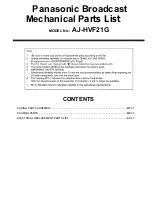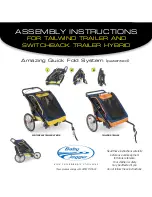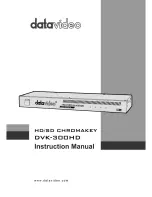
Refer to the minimum framing dimensions as per table 2. Allow a temporary lintel height (see table 2 ‘B’) from the
finished floor protector level until the firebox and flue system is installed. Install front nogs on edge to increase chimney
chase dimension.
Ensure suitable air vents (2 x 80mm diameter or equivalent) in place to vent firebox space - these maybe located in the
floor or in the side wall space. Ensure vents must be bird and vermin proofed.
Note:
Wood Installations can be converted to Gas at a later date. or have a gas ignition system fitted. Consider running a
gas supply to firebox cavity at the time of construction.
FIREBOX INSTALLATION
1. All dimensions shown for the framing trim out and metal heat shields, are based on a maximum frontal clearance
between the timber framing and the rear of the firebox fascia,
being not more than 15mm
.
2. Locate floor protector in trim out cavity. If on a concrete floor, suggest a mortar screed to the underside of the floor
protector. If on a wooden floor, screw or dynabolt in place.
3. Locate stud openings on both sides.
4. Position and ensure a strip of glass rock wool insulation is between the inner hebel leg face and the firebox. Nail
through stud into hebel leg to secure in place.
5. Locate and position firebox, fit and seal gather in cavity (refer to Cross Section). Earthquake restraints may be
positioned by drilling through firebox into the floor protector, in a position midway beneath the log-pan. Two 12mm
dynabolts or similar will suffice. Do not over tighten and deform firebox.
6. Attach rock wool to the sides & back of the firebox and gather. DO NOT BLOCK OFF the air entry between the inner
flue pipe and flue pipe casing or the air circulation between the vent holes in the cavity.
7. Once the flue system is installed, place a minimum 300mm hebel block over the top of the firebox (see Fig. 8).
Ensure the hebel block does not rest on top of the firebox
. A Lintel Bar may be required.
TIMBER FRAMING PREPARATION
6.TMWG.6
FIREBOX INSTALLATION – GAS REQUIREMENTS
Please refer to the gas burner instructions supplied with the burner for full installation of the gas burner.
1 Before installing the fire box please drill a hole on the bottom right hand side of the fire box to allow for the gas pipe to
be connected to the burner.
2. Location of the hole should align with the gap between the gas grate’s supporting legs.
3. The gas supply pipe enters the firebox above the base plate to terminate under the gas burner where it can be
connected to the gas valve.
IMPORTANT : REMOVE THE DAMPER BLADE FROM THE FIREBOX
1. Unscrew the two friction bar adjustment nuts on the left hand side of the firebox and remove the friction bar.
2. To remove the Damper Blade, push the right hand side of the blade up and move the damper blade slightly to the
right to disengage the location bar on the left hand side of the damper blade, then slowly drop the blade down and
remove it.
IMPORTANT: GAS LEAKS
1. It is important to ensure that there are no gas leaks before commissioning the burner. It is the responsibility of the gas
installer to ensure that a leak testing method, suitable for the specific installation is being used.
2. Before commissioning, gas leaks can be detected only between the supply point and the inlet to the appliance. Once
the appliance is operational, an additional check must be done for leaks inside the appliance.
NOTE: GAS INSTALLATIONS
CAN NOT
BE
CONVERTED TO WOOD BURNING AT A LATER DATE

